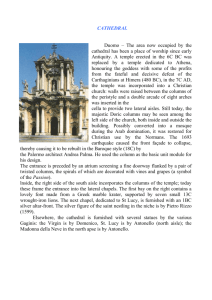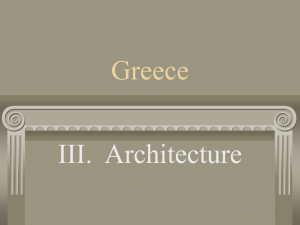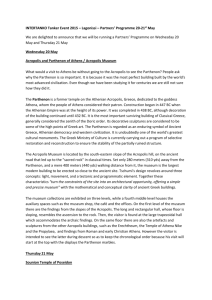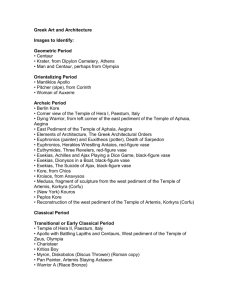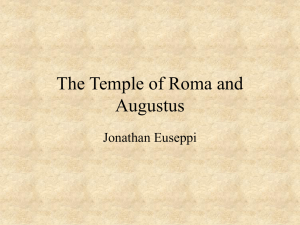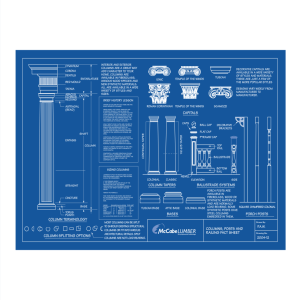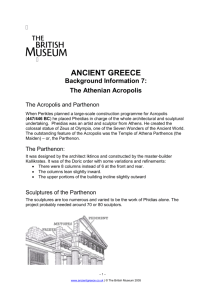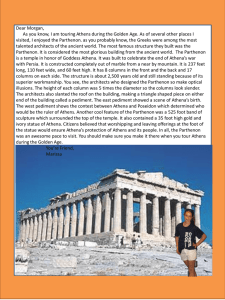ARCSHORT
advertisement
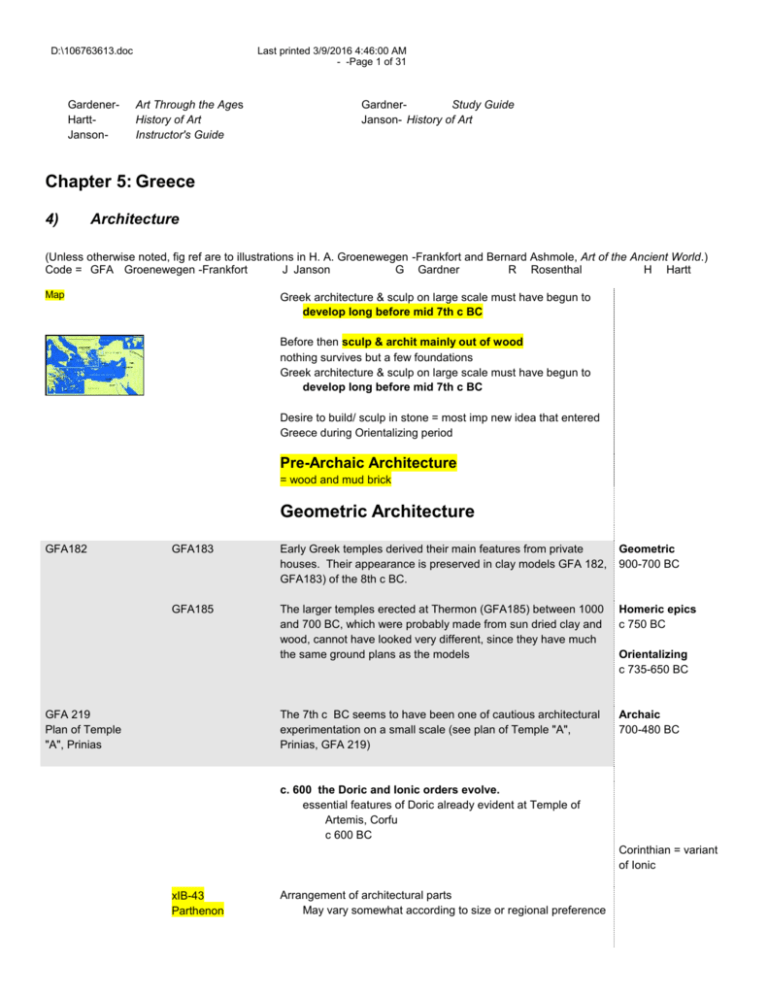
D:\106763613.doc GardenerHarttJanson- Last printed 3/9/2016 4:46:00 AM - -Page 1 of 31 Art Through the Ages History of Art Instructor's Guide GardnerStudy Guide Janson- History of Art Chapter 5: Greece 4) Architecture (Unless otherwise noted, fig ref are to illustrations in H. A. Groenewegen -Frankfort and Bernard Ashmole, Art of the Ancient World.) Code = GFA Groenewegen -Frankfort J Janson G Gardner R Rosenthal H Hartt Map Greek architecture & sculp on large scale must have begun to develop long before mid 7th c BC Before then sculp & archit mainly out of wood nothing survives but a few foundations Greek architecture & sculp on large scale must have begun to develop long before mid 7th c BC Desire to build/ sculp in stone = most imp new idea that entered Greece during Orientalizing period Pre-Archaic Architecture = wood and mud brick Geometric Architecture GFA182 GFA183 Early Greek temples derived their main features from private houses. Their appearance is preserved in clay models GFA 182, GFA183) of the 8th c BC. Geometric 900-700 BC GFA185 The larger temples erected at Thermon (GFA185) between 1000 and 700 BC, which were probably made from sun dried clay and wood, cannot have looked very different, since they have much the same ground plans as the models Homeric epics c 750 BC The 7th c BC seems to have been one of cautious architectural experimentation on a small scale (see plan of Temple "A", Prinias, GFA 219) Archaic 700-480 BC GFA 219 Plan of Temple "A", Prinias Orientalizing c 735-650 BC c. 600 the Doric and Ionic orders evolve. essential features of Doric already evident at Temple of Artemis, Corfu c 600 BC Corinthian = variant of Ionic xIB-43 Parthenon Arrangement of architectural parts May vary somewhat according to size or regional preference D:\106763613.doc Last printed 3/9/2016 4:46:00 AM - -Page 2 of 31 Three distinct influences -Egypt Mycenae, pre-Archaic Greek architecture (wood & mud brick Mycenae J153 Mycenaean Megaron Contribution most tangible Prob NOT MOST IMPORTANT Central unit of Greek temple = cella & porch = derives from megaron by continuous tradition or existing megaron G4-23 Lion Gate X6-68 Sculp pediments on DORIC pediments East Pediment Reconstruction of Temple of Zeus, Olympia E. Classical 480 - 450 High Classical 450-430 Pel War 431 - 404 Late Classical 430 - 323 Entire Mycenaean era incorporated into Greek mythology remember: Homeric epics Hellenistic 323 - 30 Mycenaean fortresses believed to be built by mythical giants- Cyclops Relationship between Myc Lion Gate & Doric pediments 8 226 0321 Doric echinus & Abacus shaft Temple of Poseidon, c 450 BC c. 750 Homeric Epics Megaron= Mycenaean royal hall = converted to dwelling place of Greek gods date XXX1 Minoan capital Archaic 700 - 480 Columns Capitals flaring cushion-like capital of Minoan - Mycenaean = closer to DORIC echinus & abacus than any Egyptian column D:\106763613.doc 62028 J79A Djoser ca. 2750 BCE Last printed 3/9/2016 4:46:00 AM - -Page 3 of 31 Egyptian Influence Shaft Minoan tapers downward Greek tapers upward- thus closer to Egyptian Fluted half columns of Zoser, Saqqara apx 2000 yrs. before Greek fluting Egyptian Influence Egyptian in ideas that = temples should be built of stone = temple required large # of columns Greeks prob learned stone cutting & masonry techniques from Egyptians From E= architectural ornament & knowledge of geometry needed in order to layout temple & fit parts together Egyptian designed to be experienced from inside Greek = experienced from outside Few allowed to enter the dimly lighted cella Religious ceremonies took place at altars erected out of doors temple facade = backdrop D:\106763613.doc Luxor Plan Last printed 3/9/2016 4:46:00 AM - -Page 4 of 31 Using the Temple at Luxor as an example, discuss the social hierarchy achieved by the Egyptian temple. begun 1390- Amenhotep III Completed by Rameses II Gateway (pylon)- Court-pillared hall-2nd courtpillared hall-temple w halls/chapels shielding Holy of Holies (sq. room with 4 columns) All enclosed by high wall that shut off the outside world Designed to be experienced from within Ordinary worshipper confined to court/ could but marvel at forest of columns that screen dark recesses of sanctuary. central axis parallel to Nile Post and Lintel 4 major features of a typical pylon temple = 1) simple massive pylon facade- Pylon = Greek for gateway 2) bilaterally symmetrical along a single axis, that runs from an approaching avenue through a colonnaded court 3) and hypostyle hall--- little open space 4) into a dimly lighted sanctuary- Holy of Holies- Square room with 4 columns Greek temple designed to be experienced from the outside. Geometric 900-700 BC Stress stone more than texture of the subject. Significant buildings began primarily as simple shrines to protect statues to their gods Homeric epics c 750 BC Eventually belief may have developed that qualities of god were embodied in the buildings themselves Orientalizing c 735-650 BC Archaic 700-480 BC D:\106763613.doc Last printed 3/9/2016 4:46:00 AM - -Page 5 of 31 Figure sculpture = important part of the construction program - to embellish the protective building - tell something about the deity inside - votive offering Early Classical 480-450 Building itself was conceived as sculpture, abstract in form and possessing the power of sculpture to evoke human qualities Marble was expensive Bluish-white stone from Hymettus, just east of Athens it was important as inspiration point of public life X4-48 Acropolis Athens Elevated site on acropolis hill above city Earliest temples were wood, later translated into stone, limestone, and marble High Classical 450 - 430 Glittering white particularly good for carving from Pentelicus (NE of city) and varying qualities from Aegean islands particularly PAROS D:\106763613.doc Still the Athenian Acropolis, Athens G5-20 6 plans Last printed 3/9/2016 4:46:00 AM - -Page 6 of 31 J182 In plan the Greek temple has close affinity with Mycenaean megaron and even at most complex it retains the simplicity of the megaron Basic Plan A single or double room (the Naos) with no windows and one door (two for a double naos) (a) portico with 2 columns between the extended walls (columns in antis. (b) colonnade across the front (prostyle) (c) a colonnade across the front and back (amphiprostyle) (d) plans surrounded by single(peripteral (e) or double (dipteral) colonnade . Remarkable for its order, compactness, and symmetry, in contrast to the rambling groupings of Egyptian temples. Answer lies in Greek sense of proportion and effort to achieve ideal forms in terms of regular numerical relations and the rules of geometry. Classical Greek architecture had a simple core or theme from which a series of complex but always quite intelligible variations is developed antaean ends D:\106763613.doc Last printed 3/9/2016 4:46:00 AM - -Page 7 of 31 Development of Greek temple scheme G5-20 (d) Plan of Temple of Hera at Olympia = similar to another great Greek invention - geometry Insistence on proportional order guided experiments with proportions of temple plans and was reflected in their sculpture, Archaic Earlier Archaic temples tended to be long and narrow proportions with ends to sides apx 1:3 Late Classical/ Hellenistic apx 1:2 Late Classical temples= little longer than twice their width Hellenistic little shorter than twice their width Proportion in architecture / sculpture and harmony in music 60293 J181 G5-21 Elevation of Greek building described in terms of the platform, column and entablature Entablature =includes everything that rests on the columns Doric / Ionic orders The combination and relationship of the 3 units = order Entire structure built of stone blocks fitted together w/o mortar stone blocks shaped w/ precision to achieve smooth joints when needed fastened together w/ metal dowels or clamps Columns with rare exceptions composed of drums Roof = terra cotta tiles supported by wooded rafters wooden beams for ceiling Constant threat of fire D:\106763613.doc Last printed 3/9/2016 4:46:00 AM - -Page 8 of 31 Comparison of Doric and Ionic Orders Basically post and lintel with architrave as lintel Doric Order Ionic Order Developed on Greek mainland capitulate, shaft no base Developed on Aegean islands, & coast of Asia Minor capitulate, shaft base dev by Greek architects of mainland Greece dev by Greek architects of Asia Minor In ancient times DORIC and IONIC temples were contrasted as In ancient times DORIC and IONIC temples were contrasted as DORIC = masculine IONIC = feminine weighty and severe in comparison IONIC seems light, airy and much more decorative Columns are more slender and rise from molded bases one theory = DORIC = translation of earlier timber structures into stone the organization of the frieze into triglyphs and metopes = best explained as a translation from wood to stone triglyphs = ends of crossbeams metopes = voids between end beams Doric - decoration applied only to the "voids" of the metopes and the pediment Ionic - willing to decorate the entire frieze and sometimes the lower drum of the columns willing to have caryatids Shallow vertical grooves = flutes fluting ridges are flat (fillets ) flutings meet in sharp ridges (arrises) Flutings are not decoration but emphasizes the vertically and rotundity - the form and function of the column Fluted shafts look stronger more energetic more resilient Occasionally replaced columns with caryatids. (probably not Doric architects) To Greeks, it was unthinkable to use surfaces the way the Egyptians used their gigantic columns - as fields for complicated ornamentation Corinthian column did not develop until 5thc BC (c. 400) D:\106763613.doc -----still----G5-21 Doric / Ionic orders Last printed 3/9/2016 4:46:00 AM - -Page 9 of 31 ------still ----temple plan CORINTHIAN order not developed until c 600 BC when it appeared on the inside of the temples Corinthian not widely used on exterior until Roman times Painted architectural sculpture Sculptural ornamentation was concentrated on upper part of building in frieze and pediments. Sculpture was painted. Paint usually applied to parts that served no sculptural support Primarily painted in red and blue with touches of green, yellow, black , and perhaps gold The Greek temple must have the clarity of Euclidean demonstration in its plan, elevation, and function enhancing decoration Greek architects thought of the temples as monumental sculpture rather than as buildings. Building placement strengthened the sculptural aspect Rites performed in front of the Temple Building itself housed the cult statue, ( and perhaps treasures, trophies) Public ritual prevailed ( private cults frowned upon) So exterior building & surface were concentrated on in effort to make it a suitable monument to deity. The history of Greek architecture is history of artists' unflagging efforts to express the form of the temple in its most satisfactory or perfect proportions Check this out D:\106763613.doc Last printed 3/9/2016 4:46:00 AM - -Page 10 of 31 Temple of Hera at Olympia X5-57 ?-GFA276 -? Temple of Hera at Olympia GFA277 Wood structures like the Temple of Hera at Olympia (GFA276), were gradually rebuilt in stone. This temple had piers projecting from the walls to help support the roof. (GFA277) GFA283 Temple of Apollo at Thermon c. 640 - 630 BC , The same (roof support) function was performed in the Temple of Apollo at Thermon (c. 640 - 630 BC , GFA283) by a row of columns down the center, Begin with Archaic DORIC architecture of the Greek colonies especially Sicily and southern Italy (Here = best preserved examples) Development of human figure = not only contemporaneous in painting and sculpture to the development in architecture but also show the same concern for proportions D:\106763613.doc Last printed 3/9/2016 4:46:00 AM - -Page 11 of 31 Hera I, at Paestum Basilica, Paestum - south of Naples G5-22 G5-23 Plan The "Basilica", Paestum, Italy, c 550 BC The "Basilica", Paestum, Italy, c 550 BC c 550 BC Typical Archaic Doric Style called Basilica by early investigators who thought it resembled the Roman building type c. mid 6th c BCE Seems low sprawling compared to Temple of Poseidon c. 460 BCE 2/4 5thc BCE dedicated to Hera Plan differs from most other Greek temples central row of columns divides the naos into 2 aisles columns directly under the ridge pole to support the roof (This feature is found only in a few early Archaic temples including the Temple of Apollo at Thermon) Disadvantages of Floorplan = - central row of columns left no place for cult statue - peripteral colonnade in order to correspond to the interior had to have an odd number of columns across the facade - which also ruled out a central doorway through which a cult statue could be viewed. J184 Corner of The "Basilica", Paestum, Italy, c 550 BC Elevation pronounced entasis large, bulky, pillow-like capitals seem more elastic, distended by weight high, massive, entablature makes columns seem squat Heaviness of the design, and narrowness of space between columns is probably the uncertainty of Archaic builders in the strength of their materials -- thus trying to have a large margin of safety. entasis = curvature of shaft capital = abacus echinus enlarged capitals = narrow gap spanned by blocks of architrave D:\106763613.doc Last printed 3/9/2016 4:46:00 AM - -Page 12 of 31 Typical Greek construction = Comparative Doric order over time Columns = dry jointed drums square metal plugs (dowels) prevent twisting & shifting whole temple this way with metal clamps holding horizontal elements and metal dowels holding vertical courses to those above and below Column evolution earliest columns (not shown ) were extremely slender under massive capitals shafts thickened to "Basilica " type then -constantly refined shafts became more slender entasis subtler capitals smaller entablature lighter Final classical proportions were considered to be "ideal ones" beyond which further refinement was impossible D:\106763613.doc Last printed 3/9/2016 4:46:00 AM - -Page 13 of 31 Temple of Poseidon Hera II at Paestum c 460 BC G5-26 Temple of Hera II at Paestum, Italy, c 460 BC 62702 G5-27 Plan and section of Temple of Poseidon G5-27 Plan of the Temple of Hera II at Paestum, Italy, c 460 BC R11601 Temple of Poseidon c 450 BC (mid 5th c BC) c 450 BC (mid 5th c BC) J185 Interior Temple of Poseidon Paestum c 460 BC (mid 5th c BC) Probably dedicated to Hera Built at a time when Doric order had already achieved classical proportions on the mainland in Temple of Aphaia at Aegina among the best preserved of DORIC sanctuaries even number of facade columns central doorway open middle aisle of 3 aisled naos permits placement of cult stature on central axis of temple, visible from outside 2 rows of Doric columns flanking the middle aisle Each row - a double tier of Doric columns. Small ones on stone course supported by larger columns below (This is standard where Doric columns supported the roof) Double tier = practical necessity for cellas of larger Doric temples Later interior supports were Ionic or Corinthian columns which were taller than Doric in relation to their diameters Tapering seems continuos despite architrave inbetween D:\106763613.doc Last printed 3/9/2016 4:46:00 AM - -Page 14 of 31 Temple of Aphaia, Aegina (c 490 BC, GFA284, J187) J187 Sectional view of Temple of Aphaia, Aeginia c 490 BC, had a double row in order not to obscure the altar. 1st see here the 2 story interior Became a practical necessity of larger DORIC temples D:\106763613.doc Last printed 3/9/2016 4:46:00 AM - -Page 15 of 31 Treasury of the Siphnians from the Sanctuary of Apollo at Delphi, 3-316-0030 G5-28A Treasury of the Siphnians from the Sanctuary of Apollo at Delphi, c. 530 BC, ArchMus, Delphi (Facade reconstructed) Pediment and Frieze c. 530 BC, ArchMus, Delphi (Facade reconstructed) One of the earliest IONIC buildings in Greece Has no IONIC columns Supports = caryatids whose style and drapery match the Ionian Kore of Athenian Acropolis (Kore of Chios) (G5-28) Identifying Ionic feature = continuous frieze that here is a part of a heavy entablature The irregular silhouettes of caryatids would never fit in a Doric temple D:\106763613.doc Last printed 3/9/2016 4:46:00 AM - -Page 16 of 31 High (Mature) Classical Period 450 - 430 BC Geometric 900-700 BC Homeric epics c 750 BC Athenians became the dominant force in the Greek world as a result of their leadership role defeating the Persians and the powerful fleet that they built in the process. Acropolis The Athenians developed a sea based empire called the Delian League under the guise of a religious, more or less democratic alliance of city - and island - states They were more the subjects of Athens than allies and Athens siphoned off a large amount of the common treasury for own use. Orientalizing c 735-650 BC Archaic 700-480 BC Early Classical 480-450 BC Pericles Athens under the adroit statesman PERICLES became immensely prosperous and proud community Brief period of Athenian glory under Pericles saw concentration of human creative energy and triumph of drama, philosophy and art known in no other place or time in western history. Athenian Acropolis Athens sacked by Persians in 480 BC destroyed the Athens Acropolis shortly before the defeat of the Persians Acropolis Acropolis sacred hill above Athens had been fortified site since Mycenaean times High Classical 450 - 430 BC Socrates 470- 399 BC Plato 427-347 BC Athenians, led by Pericles, completely rebuilding the Acropolis, one of the greatest building projects of antiquity before Roman times. G5-42 X4-5 Plan and Aerial of the Acropolis of Athens, restored as of 400 BC G5-43 Reiteration (model) of the Acropolis)of Athens toward the end of the 5th c BC; the Parthenon, (upper center), t he Erechtheion (left center), and the Propylaia and the Temple of the Athena Nike (right foreground). Royal Ontario Muss, Toronto. Aristotle 384-322 BC Athenian acropolis on towering platform of rock Archaic 700-480 Buildings on acropolis = = Classical phase in full maturity Early Classical 480-450 Of the Periclean buildings on the Acropolis High Classical 450m-m430 the Parthenon sacred to Athena Parthenos was the first and largest to be built Peloponnesian War 431-404 Late Classical 430-323 only one built before Peloponnesian War Alexander Hellenistic 323 - 30 D:\106763613.doc Last printed 3/9/2016 4:46:00 AM - -Page 17 of 31 DORIC Parthenon 448- 432 BC G5-44 IKTINOS and KALLIKRATES, the Parthenon, Acropolis, Athens, 448 - 432 BC (view from Northwest) G5-45 IKTINOS and KALLIKRATES, Southeast Corner of the Parthenon, Acropolis, Athens, 448 - 432 BC (view from Northwest) Ic-TINE-us perfect embodiment of Classical Doric Architecture final example of the evolution in architecture: the columns are more slender, the capitals smaller, the entablature lighter, and the entasis is more subtle.-to keep them from appearing hollow Architects - IKTINOS and KALLIKRATES, ICTINUS and CALLICRATES, peripteral temple short side = slightly less than its long side in ruin since 1687Turks stored gunpowder in cella. Exploded during siege Gardner Janson peripteral = single colonnade around naos Cella= unusually wide , shorter than other temples accommodates 2nd room behind G5-44 Parthenon columns Parthenon interior with Athena Parthenon Pronaos/ counterpart almost disappeared extra row of columns in front of either entrance Naos = subdivided into two parts 1. Larger part contained the cult statue of the Athena Parthenon (by Phidias, apx 40' tall) 2. Smaller division of naos = Treasury of the Delian League but most of revenues spent on bldg projects The interiors were organized differently naos- two double rows of small columns for roof support Perhaps for 2nd floor gallery from which visitors could view the statue. Pericles spent funds collected from citystates which were allies w/ Athens against Persians Athens= chief victim and victor in war against Persia This = weakened the position of Athens & contributed to their defeat in Peloponnesian War Only sanctuary to serve 4 diff faiths in succession: Greek Byzantine Catholic Cathedral Mosque (under Turks) Sculptures of the Parthenon by Phidias one of the great sculptors of all times Phidias FID-i-ass D:\106763613.doc Last printed 3/9/2016 4:46:00 AM - -Page 18 of 31 Parthenon epitomizes DORIC architecture Except for 2 IONIC elements: 1. 4 Ionic columns in Treasury part of naos 2. Continuos frieze of sculpture that runs along exterior of naos wall Despite larger size of Parthenon it seems much less massive than Temple of Poseidon J183 Temple of Poseidon foreground c 460 BCE Parthenon entablature = lower in relation to width/ height of columns Cornice projects less Columns more slender, tapering & entasis less pronounced Load carried by columns = decreased Back Basilica 550 BCE The architects, IKTINUS and KALLIKRATES, ICTINUS and CALLICRATES, realized that abstract geometric & mathematical rules were inadequate for the perfection they sought; break the rules to give the illusion that the rules had been followed-The organic must modify the mathematical to allow for human perception To make the building look perfectly balanced, they made a number of adjustments In addition to the subtle entasis used on the columns to keep them from appearing hollow, they were concerned that the building would look thinner on the corners where the light could show through the columns. They counteracted this by making the corner columns slightly thicker and by moving them closer together. Columns slanted inward, a device called "batter," and they gave the entablature a slight batter outward. continued upward In order to keep the temple from appearing to sag in the middle they raised the stylobate or base four and one half inches in the center. Greek architecture not as rational as Greek logic each capital = distorted slightly to fit curving architrave D:\106763613.doc Last printed 3/9/2016 4:46:00 AM - -Page 19 of 31 DORIC FREIZE G5-45 IKTINOS and KALLIKRATES, Southeast Corner of the Parthenon, Acropolis, Athens, 448 - 432 BC (view from Northwest) DORIC Frieze organized according to 3 inflexible rules 1. triglyph must be exactly over the center of each column 2. a triglyph must be over the center of each intercolumniation 3. triglyphs at the corners of the frieze must meet so that no space is left over. This problem of the corner triglyph was probably a constant irritation and embarassment and probably contributed to the eventual decline of the Doric order c 4th c BC and to the continuous friezes which eliminate the problem In order to solve the problem of how to have triglyphs meet at each corner, as well as have one over each column, they widened the metope space just slightly from the center outward. the insistence on clarity in argument that led Greeks to invent logic operates in their architecture Syllogism - early triumph of Greek thought 3 propositions ending in logical correct conclusion cannot be matched in Doric order. conclusion cannot be harmonized D:\106763613.doc Last printed 3/9/2016 4:46:00 AM - -Page 20 of 31 Phidias prob planned and designed the pedimental groups and friezes students and assistants carved them among most marvelous of all surviving Greek works of sculptures and among the supreme masterworks of all times Sculptures of the pediments, metopes, and great frieze compose the most elaborate sculptural program in the history of Greek art debate the arrangement of figures Agree1. East pediment group = birth of Athena = various deities, mostly sitting/ reclining witnessing birth of Athena from head of Zeus 2. West pediment group = Athena's battle with Poseidon for possession of the city British museum Elgin marbles. 1801-03 -- removed Lord Elgin British ambassador to Ottoman court at Constantinople was permitted to dismantle the sculptures and ship the best preserved ones to England He eventually sold them at a loss to the British Museum It is now believed that his removal of the sculptures was an humanitarian attempt to save them from destruction D:\106763613.doc Last printed 3/9/2016 4:46:00 AM - -Page 21 of 31 Dionysos (Herakles) East Pediment (Birth of Athena) J209 G5-46 Dionysos (Herakles?), from the east pediment of the Parthenon, Marble, over lifesize, British Museum, London, c 448 - 432 BC Final relaxation of all limitations of Archaic figurative art Knowledge of organic, coordinated human body -convincing consistency in all its parts spaciousness complete ease of movement neither violence nor pathos (suffering) deep poetry of meaning relaxed masculine body at feet of Dionysus and goddesses Phidias placed 2 horses heads repres chariots of rising sun & waning moon emerging & dying below the pedimental space. D:\106763613.doc Last printed 3/9/2016 4:46:00 AM - -Page 22 of 31 Three Goddesses, East Pediment (Birth of Athena) R4447 G5-47 Three Goddesses, from the east pediment of the Parthenon, Marble, over lifesize, British Museum, London, c 448 - 432 BC Shows the reinforcing and complementary actions of the principles of monumentality of scale and simplicity of pose with the "essential detail of actual life" Typically Phidian majestic and "real" in the reading of the relaxed forms soft fullness enveloped in thin drapery Thin and heavy fold of drapery which alternately reveal and conceal the main and lesser masses of the body Drapery unifies the group Bodies are fluidly related to each other and the drapery as well Fluid- flows, eddies around forms underneath Treatment of body and drapery = different but in functional relationship to one another complete ease of movement at feet of Dionysus and goddesses Phidias placed 2 horses heads repres chariots of rising sun & waning moon emerging & dying below the pedimental space. D:\106763613.doc Last printed 3/9/2016 4:46:00 AM - -Page 23 of 31 Metopes Lapith and Centaur G5-48 Lapith and Centaur metope from the Parthenon, Marble, 56" high, British Museum, London, c 448 - 432 BC 3/4 5th c BCE Sculptured metopes set between the triglyphs in the outer face of the Doric frieze Accent of movement by use of diagonal forms compositions of pairs of struggling figures in high relief centaurs and lapiths gods and giants Greeks and Amazons In general the metopes display the ingenuity of the Phidian school in varying the poses and attitudes of the figures and avoiding the monotony that regularly repeated space would impose The Greeks and opponents have about the same win / loss record Wedding Theseus was a Lapith D:\106763613.doc J211 R4446 G5-49 Horsemen, from the west frieze of the Parthenon, Marble, apx. 43" high British Museum, London, c 448 - 432 BC Last printed 3/9/2016 4:46:00 AM - -Page 24 of 31 G5-29 Battle of the Gods and Giants, from the north frieze of the Siphnian from the Sanctuary of Apollo at Delphi, c. 530 BC, ArchMus, Delphi (Facade reconstructed) Continuos frieze of Exterior wall of naos Within the colonnade at top of the external naos wall a continuous Ionic frieze ran around the four sides forming an unbroken band of bas- relief sculpture some 524' (525") long Poorly lit difficult to see placed immediately below the ceiling Illusion of space and rounded forms = more advanced than Treas of Siphnians 3/4 5th c Horsemen rhythmic grace spirited movement of horsemen G5-50 Head of the Procession, from the east frieze of the Parthenon, Marble, apx 43" high. Louvre, Paris Subject is still a matter of scholarly dispute 1) Procession honoring Athena in presence of other Olympic gods or probably represents 2) Panathenianaic procession took place every 4 years when citizens of Athens gathered in market place & carried the Peplos (or robe) for the statue of Athena to the Parthenon (an Archaic sculpture of Athena not Phidias's) This = the first non- mythological subject in Greek temple reliefs = unique in the ancient world for its careful creation of the passage of time effect is achieved by use of a sequence of figures posed to present a gradation of motion. D:\106763613.doc G5-42 Plan of the Acropolis of Athens, restored as of 400 BC Last printed 3/9/2016 4:46:00 AM - -Page 25 of 31 J191 G5-51 IMNESIKLES, the Propylaia, Acropolis, Athens, 437 - 432 BC (view from the east) X4-62 Plan of Propylaia and Athena Nike Propylaia, (Propylaea) G5-51 MNESIKLES, 437 - 432 BC MNESICLES,= architect Other buildings of the Acropolis, Athens Monumental entry gate at west end of Acropolis part of Periclean building project Marble Begun immed following completion Parthenon 1. never finished (main part built) partly due to financial burden of the Peloponnesian War2. X4-52 Plan of Propylaia one of wings would have trepasses on sanctuary of Artemis Bauronia Resting place after steep climb before going on to sacred buildings Built on irregular steeply rising site X4-59 Cross Section of Propylaea J193 Propylaea (view from east and Temple of Athena Nike (427-424), Acropolis, Athens MNEE-sik-lees East FacadeWest facade would have been similar Modification of the Doric regularity in broadening the space betw central columns make passageway wide for wheeled traffic West FacadeJ192 The Propylaea (w/ pinakoheke), Western entrance flanked by two wings Gate Hall itself flanked by buildings containing a library and perhaps the first picture gallery (pinakotheke) in history Contains IONIC elements 1. columns that line the corridor (that give greater height to support central roof structure Greek buildings ordinarily existed in isolation, self-sufficient, and relatively independent of surroundings Athenian architecture at time = trend toward using IONIC elements inside DORIC structures Remember sculpt frieze inside Parthenon) G5-54 Reconstructed elevations of the east and west facades of the Erechtheion, Acropolis, Athens, 421 - 405 BC Propylaia = innovative in that buildings of different types & functions (propylene &halls) were combined into axially aligned groupings that look ahead to later Hellenistic designs & axial composition of Roman imperial forums. D:\106763613.doc Last printed 3/9/2016 4:46:00 AM - -Page 26 of 31 IONIC TEMPLES Athens= strong Aegean orientation hospitable to eastern Greek building style from mid 5th c on Previous known dev of IONIC= fragmentary Huge Archaic IONIC temples = on Samos | gen. known = at Ephesus | only in plans IONIC columns diff from Doric = ornate profiled base = more slender shaft = less tapering and entasis = large double scroll, volute, capital IONIC columns echo from of growing plant formalized palm plant J194 Aeolian capital, from Larissa, c 600 BC Archaeological Museum, Istabul J194 Aeolian capital, from Larissa, c 600 BC early ancestor of Ionic capital D:\106763613.doc Last printed 3/9/2016 4:46:00 AM - -Page 27 of 31 Temple of Athena Nike Built under direction of KALLIKRATES c. 427 - 424 BC X4-62 Plan of Propylaea and Temple of Athena Nike LaCour slide Temple of Athena NKK G5-52 KALLIKRATES, the Temple of Athena Nike, Acropolis, Athens, 427 - 424 BC (view from the east) amphiprostyle ionic temple on site of Mycenaean bastion near Propylaia Slender, exquisite proportions contrast Doric severity of gate unit Earliest completely Ionic building in existence on the Acropolis Before now IONIC order had been employed in construction of a whole building only in cases of a few treasures at Olympia and Delphi (Treasury of Siphnians) these buildings were constructed by Aegean islanders not by Greeks on mainland Athens rule of the islands opened the city to eastern Greek and Ionian influences Athenian architects took up Ionic order c 450 BC 1st thought only suitable for small temples of simple plan a prostyle temple (a colonnade across front) plus a porch added at rear. D:\106763613.doc Last printed 3/9/2016 4:46:00 AM - -Page 28 of 31 Erechtheion 421- 405 BC perhaps erected by Mnesicles R4461 G5-55 G5-53 The Erechtheion, Acropolis, Athens, 421 - 405 BC Porch of Maidens, The Erechtheion, Acropolis, Athens, 421 - 405 BC J196 The Erechtheum (view from the south), Acropolis, Athens. 421-405 BC Ionic Last of the Periclean program Most unusual in plan and unlike any other Greek temple largely due to its irregular site and partly due to the number of shrines included in it. Northern edge of Acropolis opposite the Parthenon Named after the mythological Athenian hero ERECTHEUS--king of Athens Erechtheion stands on traditional site of contest between Poseidon and Athena for domination over Athens Adapted to irregular, sloping site X4-66 Plan of Erechtheion X4-65 Erechtheion North Doorway Asymmetrical plan resulted from need to bring traditionally revered sites together &the pious reluctance to disturb sacred places included terracing sacred ground. as a result =several levels with porches projecting from three sides & an unusual screen wall closing off the fourth. eastern room = dedicated to Athena Polias Athena= city goddess believe the Erechtheion=finished according to plan. Asymmetrical form = effective counterpoint to the symmetrical unity of the Parthenon several religious functions Sculpture confined to frieze except for caryatids Bare pediments lack of resources due to Peloponnesian War? Delicate/ rich ornamental carving on bases/ capitals frames of doorways/ windows Erechtheion 421- 405 BC Porch of Maidens Early Classical 480-450 -----still ----G5-55 Porch of Maidens, The Erechtheion, Acropolis, Athens, 421 - 405 BC small porch facing Parthenon Graceful caryatids Striking complement to the severity of Parthenon's doric columns High Classical 450-430 Late Classical 430-323 D:\106763613.doc Last printed 3/9/2016 4:46:00 AM - -Page 29 of 31 AFTER CLASSICAL SCULPTURE Emphasis on ornament = characteristic of late 5th c J195 corinthian capital, from the Tholos at Epidaurus, c 350 BC, Museum, Epidaurus Corinthian capital = elaborate substitute for Ionic capital shape = inverted bell covered with curly shoots/ leaves of acanthus plant 1st only used on interiors Monument of Lysicrates Athens c. 334 BC J198 The Monument of Lysicrates, Athens, c 334 BC G05-70A The Monument of Lysicrates, Athens, distant view c 334 BC Earliest use of Corinthian capital on exterior Not really a building The hollow interior has no entrance Elaborate support for tripod won by Lysicrates in a contest Miniature version of a tholos Engaged columns to make monument more compact Later was employed on larger building IN Roman times Corinthian = standard capital for almost any purpose D:\106763613.doc Last printed 3/9/2016 4:46:00 AM - -Page 30 of 31 Architectural vocabulary aesthetically and technically remained essentially that of the temples of late 5th c Only increase in repertory = Open Air Theatre Open Air Theatre Theater, Epidaurus c 350 BC achieved regular, defined shape Before 4th c auditorium = natural slope = perfectly curved = equipped with stone benches R23072 J199 The Theatre Epidaurus, c 350 BC J200 Plan of the Theater Epidaurus, (after PicardCambridge) Now- hillside = concentric row of seats at regular intervals Center = orchestra where most of action took place Extreme right = remains of hall like building formed backdrop/ supported scenery D:\106763613.doc Last printed 3/9/2016 4:46:00 AM - -Page 31 of 31 Limitations of Greek Architecture Concern with monumental exteriors at expense of interior space concentration of effort on temples of one particular type Lack of interest in any system other than post and lintel
